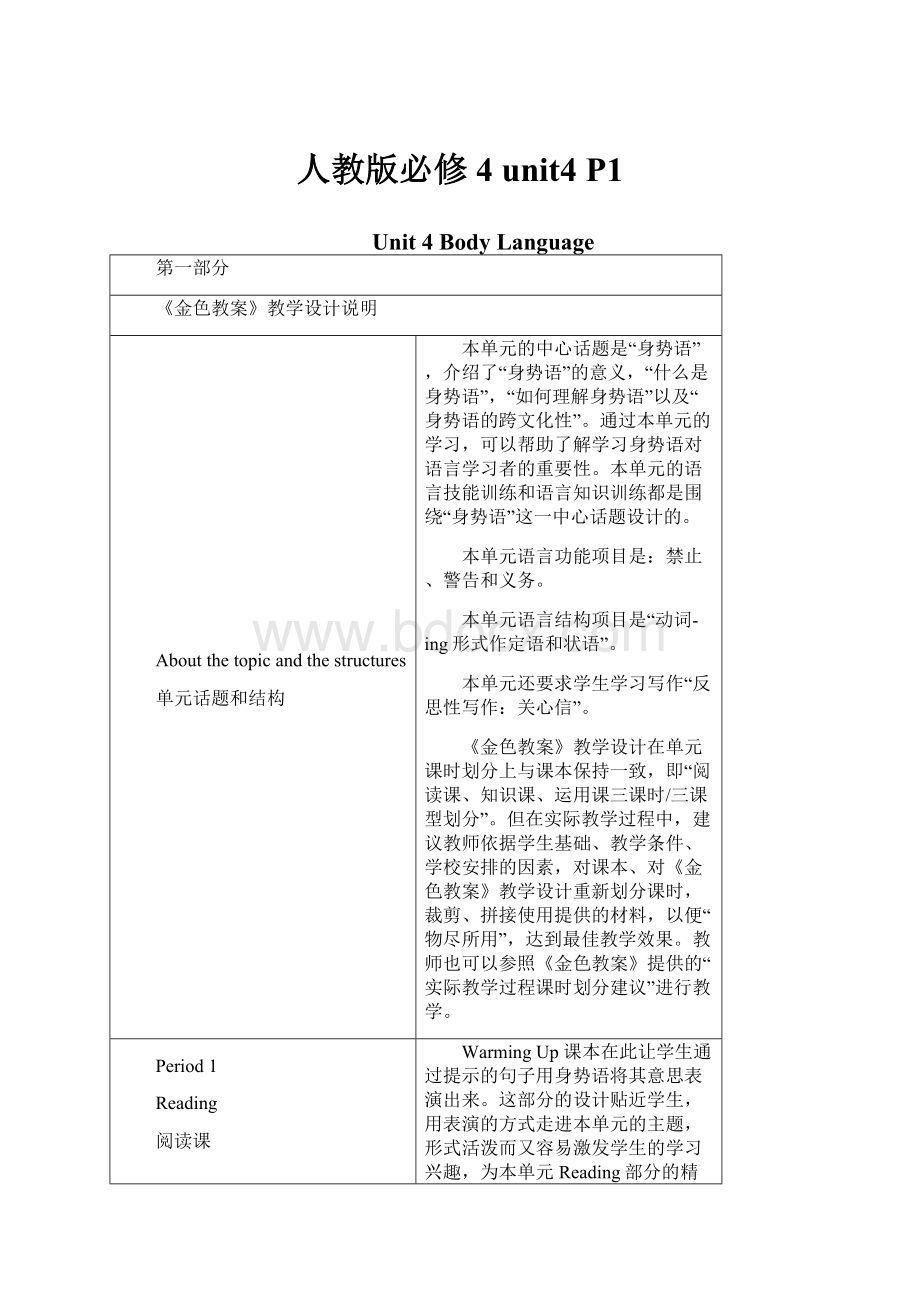人教版必修4 unit4 P1.docx
《人教版必修4 unit4 P1.docx》由会员分享,可在线阅读,更多相关《人教版必修4 unit4 P1.docx(13页珍藏版)》请在冰豆网上搜索。

人教版必修4unit4P1
Unit4BodyLanguage
第一部分
《金色教案》教学设计说明
Aboutthetopicandthestructures
单元话题和结构
本单元的中心话题是“身势语”,介绍了“身势语”的意义,“什么是身势语”,“如何理解身势语”以及“身势语的跨文化性”。
通过本单元的学习,可以帮助了解学习身势语对语言学习者的重要性。
本单元的语言技能训练和语言知识训练都是围绕“身势语”这一中心话题设计的。
本单元语言功能项目是:
禁止、警告和义务。
本单元语言结构项目是“动词-ing形式作定语和状语”。
本单元还要求学生学习写作“反思性写作:
关心信”。
《金色教案》教学设计在单元课时划分上与课本保持一致,即“阅读课、知识课、运用课三课时/三课型划分”。
但在实际教学过程中,建议教师依据学生基础、教学条件、学校安排的因素,对课本、对《金色教案》教学设计重新划分课时,裁剪、拼接使用提供的材料,以便“物尽所用”,达到最佳教学效果。
教师也可以参照《金色教案》提供的“实际教学过程课时划分建议”进行教学。
Period1
Reading
阅读课
WarmingUp课本在此让学生通过提示的句子用身势语将其意思表演出来。
这部分的设计贴近学生,用表演的方式走进本单元的主题,形式活泼而又容易激发学生的学习兴趣,为本单元Reading部分的精彩故事做好了铺垫。
教师也可以采用本书的“热身”设计:
Warmingupbyacting,Warmingupbydefining—Whatisbodylanguage?
进行热身教学。
Pre-reading课本通过四个问题使学生明白“身势语”的不可替代性,激发学生的阅读兴趣;教师也可以以Pre-readingbylookingandsaying形式进行预读/读前教学。
Reading是一篇记叙文,开头以一个接待员的身份观察来自不同国家的客人刚见面时对身势语的不同反应,从而引出文化不同而体态语不尽相同的中心话题。
本书提供了如下程序设计:
Talkingandsharing,Listeningandreadingaloud,Readingandunderlining,Readingtoidentifythetopicsentenceofeachparagraph,Readingtodecideonthetypeofwritingandsummaryofthetext,Readingtomakeadiagramofthetext,Readingandunderstandingdifficultsentences,Closingdownbycheckingcues。
Period2
Learningaboutlanguage
知识课
LearningaboutLanguage分为两部分,Discoveringusefulwordsandexpressions是本单元的词汇练习题;Discoveringusefulstructures是本单元的语法练习题,通过本单元的学习,要求学生熟练掌握-ing形式作定语和状语的语法功能。
本书下列教学程序设计可供参考:
Warmingupbydiscoveringusefulwordsandexpressions,Readingandthinking,Doingexercises,Goingoverthereadymaterialsforthe~ingformastheadverbial,Doingexercisesforconsolidation,Closingdownbydoingaquiz。
Period3
Usinglanguage
运用课
UsingLanguage分为三部分,Reading部分要求学生通过阅读另一篇文章了解更多的身势语文化。
Listeningandspeaking要求通过六幅图和听力内容说出故事中的体态语言,并用相关句型把它写出来,有利于学生写作能力的提高。
第三部分speakingandwriting通过观察讨论林珮的体态语言,分析她的心态,并给她提出建议,这是由身势语引出的一个开放性写作。
教师可以参考使用本书提供的如下设计:
Readingandunderlining,Readandunderlinealltheusefulexpressionsorcollocationsinthepassage,Doingexercises,Makingalistofbodylanguageexpressions,Makealistofthreepositivebodylanguageexpressionsandthreenegativebodylanguageexpressions,Speakingandwriting,Closingdownbysummarizingbodylanguage。
实际教学过程课时划分建议
Period1
将WarmingUp、Pre-reading、Reading和Comprehending整合在一起上一节“阅读课”。
Period2
将Learningaboutlanguage和Workbook中的USINGWORDSANDEXPRESSIONS、USINGSTRUCTURES整合在一起上一节“语言知识课”。
Period3
将Usinglanguage设计为一节包括听说读写单项技能或组合技能训练的“综合技能课
(一)”。
Period4
将Workbook的READINGANDLISTENING和TALKING整合在一起上一节“听说课”。
Period5
将Workbook的LISTENINGTASK、READINGANDWRITINGTASK和SPEAKINGTASK整合为一节“综合技能课
(二)”。
第二部分
教学资源说明
Section1
Background
背景
围绕单元话题“Festivalaroundtheworld”,《金色教案》提供了几则语言规范、短小精干的趣味性材料。
这些材料既可以作为教师教学参考材料为教师所用,也可以直接或改写、重组后作为课堂内外的拓展性阅读材料呈现给学生。
Section2
Explanation
解析
重点针对“阅读课型”中的课文难句,《金色教案》不仅提供了详尽的,就句论句的解析和翻译,而且还以解析的焦点话题为线索,进行了一定的归纳、辨析和总结,以帮助教师更好地实施“语言形式”的教学。
Section3
Vocabulary
词汇
按照课本单元词汇表顺序,《金色教案》重点提供动词、短语搭配的讲解。
所提供的例句,经典、地道、实用、易懂,完全可以直接用于教学。
第三部分
教学测评说明
围绕单元词法、句法项目,《金色教案》提供了长短不一的“单元教学测评”,并备有参考答案供教师使用。
有些测评题目直接源于历年高考试卷,更具有说服力和实用性。
Part1TeachingDesign
第一部分教学设计
Period1Asamplelessonplanforreading
(COMMUNICATION:
NOPROBLEM?
)
Introduction
Inthisperiod,afterthewarmingup,studentswillfirstbeguidedtotalkandshare.Thencomeslisteningandreadingaloud,readingandunderlining,readingtoidentifythetopicsentenceofeachparagraph,readingtodecideonthetypeofwritingandsummaryofthetext,readingtomakeadiagramofthetextandreadingandunderstandingdifficultsentences.Theperiodendsinstudentscheckingcues.
Objectives
Tohelpstudentsunderstandthetext’sformsandcontentsandlearnaboutbodylanguage
Tohelpstudentscommunicateonthetopicinfocuswiththewords,expressionsandstructureslearnedinthisunit
Focus
Words
greet,represent,approach,defend,misunderstand,dash,frown,misread,
ease,yaw,hug
Expressions
belikelyto,ingeneral,atease
Patterns
1.Fourpeopleenterlookingaroundinacuriousway.
2.ThefirstpersonwhoarrivesisMr.GarciafromColumbia,closelyfollowedbyJuliafromBritain.
3.Notallculturesgreeteachotherthesameway,noraretheycomfortabletouchingstrangersorbeingtoocloseortoofaraway.
4.PeoplefromplaceslikeSpain,ItalyorSouthAmericancountriesapproachotherscloselyandaremorelikelytotouchthem.
Aids
Multimediafacilities,tape-recorder,photos,diagrams
Procedures
1.Warmingup
Warmingupbyacting
Lookatthelistofinterpretationontherightsideofthechart.Performtheactionorthenonverbalbehaviorontheleftside.
ExamplesofBodyLanguage
NONVERBALBEHAVIOR
INTERPRETATION
Brisk,erectwalk
Confidence
Standingwithhandsonhips
Readiness,aggression
Sittingwithlegscrossed,footkickingslightly
Boredom
Sitting,legsapart
Open,relaxed
Armscrossedonchest
Defensiveness
Walkingwithhandsinpockets,shouldershunched
Dejection
Handtocheek
Evaluation,thinking
Touching,slightlyrubbingnose
Rejection,doubt,lying
Rubbingtheeye
Doubt,disbelief
Handsclaspedbehindback
Anger,frustration,apprehension
Lockedankles
Apprehension
Headrestinginhand,eyesdowncast
Boredom
Rubbinghands
Anticipation
Sittingwithhandsclaspedbehindhead,legscrossed
Confidence,superiority
Openpalm
Sincerity,openness,innocence
Pinchingbridgeofnose,eyesclosed
Negativeevaluation
Tappingordrummingfingers
Impatience
Steeplingfingers
Authoritative
Patting/fondlinghair
Lackofself-confidence;insecurity
Tiltedhead
Interest
Strokingchin
Tryingtomakeadecision
Lookingdown,faceturnedaway
Disbelief
Bitingnails
Insecurity,nervousness
Pullingortuggingatear
Indecision
Warmingupbydefining—Whatisbodylanguage?
*Thegestures,poses,movements,andexpressionsthatapersonusestocommunicate.
*Theoutwardsignsofapersonwhichindicatetheirinnerthoughtsorattitude.Forexample,abowedheadindicatessubmission,ahandoverthemouthindicatesthepersondoesn’twanttotalkorfeelstheirwordsaren’tworthlisteningto.Scratchingindicatesnervousness.Apersonpassinganotheronthestreetmightbowtheirheadasasubconscioussignofsubmission.
*Consciousorunconsciousbodilymovementsandgesturesthatcommunicatetoothersaperson’sattitudesandfeelings.Thismayalsoincludedress,facialfeatures,skincolourorotherpersonalmeansofcommunicationwithoutwords.
*Communicationviathemovementsorattitudesofthebody
*Bodylanguageisabroadtermforseveralformsofcommunicationusingbodymovementsorgestures,insteadof,orasacomplementto,sounds,verballanguage,orotherformsofcommunication.Inturn,itisonecategoryofparalanguage,whichdescribesallformsofhumancommunicationthatarenotlanguage.
2.Pre-readingbylookingandsaying
Lookatthemaninthepicturebelow.Whatdoeshesaytoyoubyhisbodylanguage?
Basically,howthe......doIknow?
Or,Idon’tknownothing!
Theshouldersarehunchedandthehandsareopensignifyingabigquestionmark.
3.Talkingandsharing
*Bodylanguageisthequiet,secretandmostpowerfullanguageofall!
*Accordingtoexperts,ournon-verballanguagecommunicatesabout50%ofwhatwereallymean(voicetonalitycontributes38%)whilewordsthemselvescontributeamere7%.
*Ourbodiessendoutmessagesconstantlyandoftenwedon’trecognizethatwe’recommunicatingalotmorethanwerealize.
*Ourunderstandinganduseofnon-verbalcuesinfacialexpressionarefamiliartousnearlyfrombirth
4.Listeningandreadingaloud
Readingaloudtotherecordingofthetextimprovesourliteracyskills--reading,writing,speaking,andlistening.NowpleaselistenandthenreadaloudtotherecordingofthetextCOMMUNICATION:
NOPROBLEM?
Payattentiontothepronunciationofeachwordandthepauseswithineachsentence.
5.Readingandunderlining
Areallyusefulwaytohelpuswithourlisteningistobecomeawareof'thoughtgroups'.
Whenwespeak,weneedtodividespeechupintosmall'chunks'tohelpthelistenerunderstandmessages.Thesechunksorthoughtgroupsaregroupsofwordswhichgotogethertoexpressanideaorthought.InEnglish,weusepausesandlowpitchtomarktheendofthoughtgroups.
Nextyouaretoreadthetext,dividingthetextintothoughtgroupsandcirclingalltheusefulexpressionsorcollocationsinthepassage.Copythemintoyournotebookafterschoolashomework.
CollocationsfromCOMMUNICATION:
NOPROBLEM?
send…todosth.派……做某事,meet…attheairport去机场接……,meetwith…偶遇;碰到,atahotel在旅馆里,representtheChinesegovernment代表中国政府,lookaround环顾四周;左顾右盼,inacuriousway以奇特的方式,befollowedby后面紧跟着,introduce…to…把……介绍给……,kiss…onthecheek吻……的面颊,stepback向后退,appearsurprised显得很吃惊,takeafewstepsawayfrom…躲开……几步,atthesametime与此同时,reachone’shandoutto…向……伸出手去,touchsb’shand碰到(接触)某人的手,greeteachother彼此问候,communicatewithspokenlanguage用口语交流,expressone’sfeelings表达某人的感情,useunspokenlanguage不用语言,keepphysicaldistance身体保持一定的距离,standcloseto…与……站得近,approach…closely向……靠近,shakehands握手,movebackabit向后退,nodat…向……点头,behavethesameway表现地一样,avoiddifficulty避免困难
6.Readingtoidentifythetopicsentenceofeachparagraph
Nextyouaretoskimthetexttoidentifythetopicsentenceofeachparagraph.
7.Readingandtransferringinformation
Readthetextagaintocompletethetable.Whereishe/shefrom?
Whatdoeshe/shedowhenhe/shemeetssomeoneattheairportforthefirsttime?
Name
Country
Action
Meaning
MrGarcia
JuliaSmith
GeorgeCook
AhmedAziz
MadameCoulon
Forreference
Name
Country
Action
Meaning
MrGarcia
Columbia
TouchingJuliaSmith’sshouldersandkissingheronthecheek
Greetingpeople
JuliaSmith